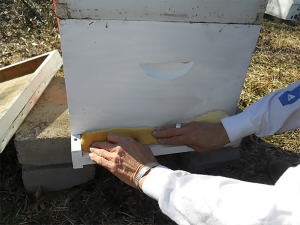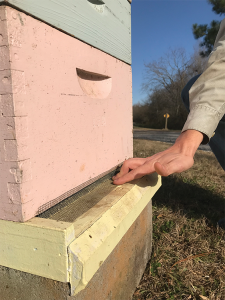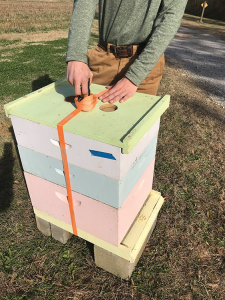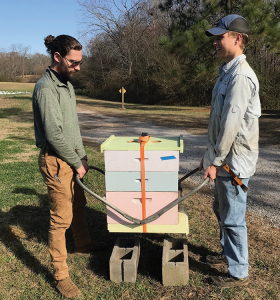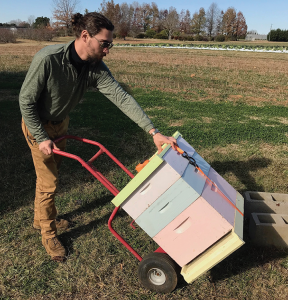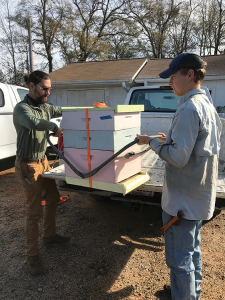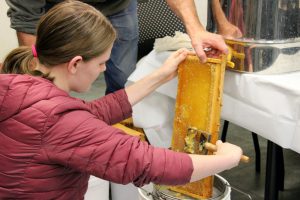By: Jennifer Berry
When You Have To, Be Prepared.
This past October, (and for several years now), it has been unseasonably warm with occasionally temperatures reaching the upper 80s to lower 90s. Not only has it been hot, it has also been exceptionally dry. This type of weather pattern, especially in the Fall, tends to bring out the worst in the insect world. Yep, that’s right, it’s yellow jacket time, and they were flying around in droves. Not sure why, maybe the warmer temperatures trigger the queens to continue laying eggs, thereby creating an overabundance of these lovely hymenopteran relatives? This year I was noticing them everywhere; in the garden, swarming around the compost bin, and whirling about on the back porch. They were also especially annoying while working colonies since they were buzzing around frames or dancing about on hive tools sticky with honey. And then of course, these nasty pests constantly flying around your face and neck while trying to wrap up Fall chores. Very annoying.
We had an apiary around a ½ mile from a farm which offered all sorts of Fall activities geared towards children. Festive games such as a corn maze, corn hole, and pin the corn cob on the stalk. There were also hay and pony rides, pumpkin picking and face painting to mention a few. The kind of events that attracts folks from all ages, groups and walks of life.
On this particular day, I was in my office working on an article for Bee Culture, I’m sure when the phone rang. Answering in my most professional manner of course, I could tell immediately by the tone of the voice on the other end, that the gentleman was not happy. He introduced himself and quickly began to accuse my bees (actually the lab’s bees) of RUINING his livelihood. I didn’t argue or put up a fuss. I just sat back and listened to him rage. According to his story, our bees were chasing his customers away. They were scaring the children because they were swarming around trash barrels, the hand-held soda cans and cotton candy. He knew exactly where our research colonies were located and we better move those bees NOW or he’s going to call the authorities. After he calmed down a bit and took a breath, I volunteered to drive over to his farm and take a look; this seemed to appease him for the moment.
A few minutes later I loaded myself and our graduate student into the truck and off we drove. When we arrived at the farm, we quickly found out that the owner (gentleman on the other end of the phone) was currently out of town but his wife would be with us shortly. I breathed a sigh of relief, since I was not looking forward to meeting him face to face.
After just a few moments, the wife walked up and began to show us around. Right away, she pointed out the trash cans and sure enough, there were swarms of flying insects, but very few honey bees; most the bugs were yellow jackets. Seriously, for every 100 yellow jackets, we would see maybe one honey bee. We explained this to the women, plus advised her that they should invest into getting lids for the cans. It wouldn’t solve the problem but it would cut down on the attractiveness of the sugary sweets laying around inside. I also suggested that we could spray the cans with a concoction that we use to run honey bees out of honey supers. “It may not work”, I explained, “but let’s give it a try”. I told her I’d be by the next day to drop it off. She couldn’t have been nicer. She walked us out of the area and back to our truck, again being extremely pleasant and appreciative for the advice.
The next day I showed up with the liquid but this time was not greeted by the pleasant “wife” but instead by the very annoyed, very tall, very intimidating “husband”. As I walked through the gate, here he came, roaring up on his four-wheeler, dust flying up like a rooster’s tail behind him. Just before knocking me to the ground, he stopped, jumped off the rig and began yelling at me, just inches from my face. As the dust from the road settled around us, he was telling me that “all you snooty university types are all the same, thinking that your research is more important than what the working man was doing to make a living.” I couldn’t get a word in edgewise, so I dropped the container of liquid onto the counter at the ticket office and hurriedly walked toward my truck. Meanwhile, he was still cussing me up one side and down the other. Telling me . . . “if those bees were not gone by tomorrow he was going to poison them.” That’s when I stopped dead in my tracks, turned around, walked calmly back to him, and coolly said, “Sir that would not be a good idea, since it would be against the law to purposefully kill bees, especially ones involved in a USDA/UGA research grant.” I also tried to explain to him that the majority of the “bees” flying around were not honey bees but in fact yellow jackets, and even if we did move the bees, they would still have the same problem. He was not hearing any of this since he kept repeating, “I know the difference between a yellow jacket and a honey bee! I have a degree in agriculture from the University of Florida!!!” Figures! (ok had to make the collegiate jab). Since there was no getting through to him, I just walked away for the second time even as the vocal bombardment continued.
When I got back to the lab, I immediately reported the incident because I could tell this guy was going to be trouble. Even though I normally wouldn’t cower under threats from a bully, I was concerned he would do something harmful to our bees since his farm butted up to the farm where our research colonies were located. We decided to load them up that evening and move them to a different location.
Moving bees is not fun, under any situation, or anytime of the year, however, when temperatures and humidity are high, it can make it hard on the beekeeper but even harder on the bees. Since we weren’t going too far, I wasn’t overly concerned. Most times, when we aren’t under dire conditions, we choose to move bees during the colder months, not the middle of the Summer. Anytime of year, when the day time temperatures are chilly enough to keep the bees in the hive, that’s when we choose to move them. Moving bees in the light of day is far less stressful than stuffing, strapping, loading, traversing roads and fields, unloading, placing, and un-stuffing entrances during the darkness of night. That’s why February is an excellent month to move bees since daytime temperatures are still relatively cool.
For those of you moving bees for the first time, there’s a few pointers that I’ve learned over the years. First and foremost, take your time!!!! Never, never, never get into a hurry while moving bees. Moving bees is not easy and when something goes wrong, it can be bad, really bad, dangerous even. So please, take your time, be prepared and always expect the unexpected. And, bring extra of everything and then some!
Before you ever pick up that first hive, make sure the location you plan to place the bees is ready for their new occupants. Prepare the area where you plan to put the hives by clearing any brush, or tall grass. I always keep several yards around the hive neat and tidy, especially in the front of the hive so it is navigable for the bees returning home. Plus, the apiary must have easy access with a truck and trailer. Once the spot you plan to place your bees is looking like the manor at Downton Abbey, you want to place and level the blocks or stands that the hives will rest upon. Very important that whatever you choose to place the hive(s) onto is sturdy and level! You don’t want the hive(s)to tip over, especially during the winter months when you may not notice them for days to weeks.
Once the location is ready, it’s time to get the moving gear in order. The following list is what we use to move bees. There are many different items you can choose, but this is what has helped us over the years safely move bees: trailer and/or bed of a pickup, smoker, pine straw, lighter, hive tools, moving straps, rope, duct tape, bungee cords, hive lifter, hand truck, material to stuff the entrance (Winter we use foam that completely closes off the entrance: Summer we use screen or wire mesh for ventilation), first aid kit, fire extinguisher, water bucket, tool box, hammer and nails, flashlights, and charged up cell phones. Hopefully, some of these items will never be used but it is always better to be safe than sorry.
- Using foam to close the entrance during Winter.
- Using hard ware cloth to screen the entrance during Summer.
- Strapping a colony with ratchet straps.
If temperatures are still warm, we suggest you move bees in the evening hours, to make sure all the girls have made it back home. Trust me, you don’t want to leave anyone behind. Not only will the poor little bees die, but they will not be happy that someone took their home away; TRUST ME on the latter. Even though in the above situation (summertime) we had to move bees during the evening hours, I strongly recommend that you move bees during the light of the day and during the colder months of Winter as I mentioned above. One more point here, since bees can be knocked out of the cluster while being moved, you may want to wait to relocate them if it is going to be bitterly cold since they will be unable to crawl back and will die. That is why we try to pick days where night-time temperatures are in the 30s to 40s and day time temps are in the 50s. We get to the apiary early in the morning and close the entrances before the bees are flying. By the time they are loaded and we are driving, the temps have warmed up enough so that if they do hit the bottom board, they will be able to crawl back up. February is a perfect month for us since there are always days that fall into the above temperature ranges.
Now that the apiary is prepared and the gear is loaded, ready, set, go. The first thing we do, whether cold or hot, light or dark, is smoke the entrances. This will cause the bees to go inside if any are lingering on the front porch. Then we close the entrances, paying close attention to any holes or cracks at the ends, so no bees can escape. After the entrances are securely closed, we strap the colonies. I prefer using moving straps as opposed to hive staples. I’ve had issues in the past with hive staples coming loose over time, allowing hive bodies to slip apart, and releasing bees. However, everyone has a method they prefer. For me, strapping colonies is easy and not too expensive. The main issue here is to make sure the straps are cinched down tight and the loose pieces are tied securely so that they’re not flapping around or getting tangled up.
After all the colonies are strapped it’s time to move them into the bed of the truck or onto a trailer. Two person hive lifters work nice for lighter colonies, or adjusting colonies once loaded but for the larger double-deeped, or triple-supered ones, a hand truck comes in “handy”. Word of caution here; if your bottom boards are screened, you need to make sure the tongue of the hand truck is long enough or wide enough to clear them. Otherwise, you may puncture your screen.
Once colonies are loaded it is very important that they are strapped to the trailer or the truck bed. Insert motto again: “Better to be safe than sorry!” Swerving to miss a critter in the middle of the road or having to stop suddenly to avoid crashing into the vehicle that just pulled out in front of you, can wreak havoc on unsecured hives. Sudden changes in direction or speed can result in hives tipping over and breaking apart, which is not a good thing! Now it’s time to take the girls to their new home. Try not to beat any speed records while pretending to be Mario Andretti, just take your time.
- Two person hive lifter makes moving hives much easier.
- Hand truck also can make moving hives a breeze (well kind of).
- Hive being placed into the truck.
Unloading can be hard on the ole back, but I always breathe a sigh of relief once we and the girls have made it unscathed, and safely to our destination. Also, unloading colonies, especially heavy ones, can be tricky, so it’s always a good idea to have at least two people while moving bees. Slowly take bees off the trailer or back of the truck, being careful of top heavy colonies that tend to tip over.
Once the colonies are in place, it’s time to put on a veil, remove the straps and unplug entrances. Even if it is cold outside, I HIGHLY recommend you wear a veil at least. I’ve unstrapped and unscreened plenty of colonies over the years, and have learned to be ready to take off running, if need be. Our girls do not like being screened, loaded, unloaded and bounced down roads, therefore, they will come out and let you know how displeased they are, so be prepared; even a puff of smoke can help. Once they are successfully placed, unstrapped, and unscreened, check to make sure they are stable in their new location. After which, it is time to pack up the equipment, jump in the truck and head home for a warm cup of tea, or in his case a cold iced tea.
Even though the gentleman mentioned earlier was not very kind and very misinformed, it was a good idea to go ahead and remove the girls from potential harm. By the way, his flying hymenopteran problem didn’t go away even after the hives were gone. Hearing through the grape vine, they finally invested in tight fitting lids for the garbage cans and signage asking folks to keep the lids closed. Over the years, we’ve moved bees due to complaints about them landing in swimming pools or annoying guests while soaking in hot tubs. I always want to be mindful of our bees and don’t want them ever to be a problem, even when they’re not. Sometimes to be a good neighbor we have to just grin and bear it, even when we know we are right. Right?
Be good to you and your bees.
Jennifer Berry is the Research Leader at the University of Georgia Honey Bee Lab.








